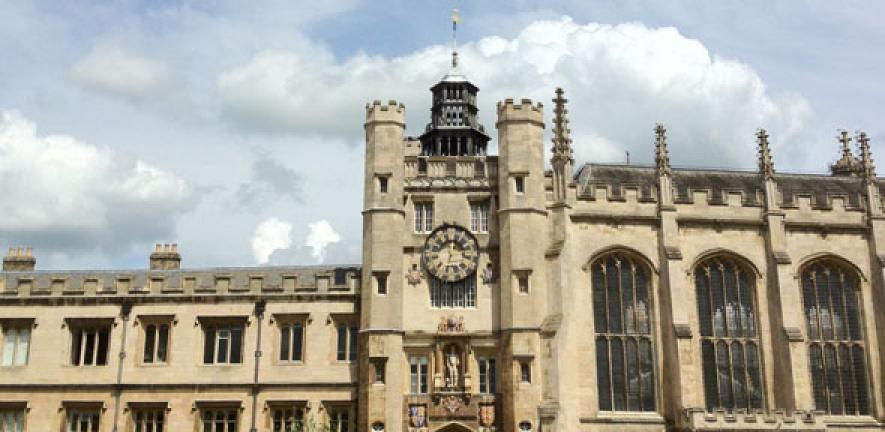
Hugh Hunt (Department of Engineering) discusses the history of the Trinity College clock and how it keeps time.
Hugh Hunt (Department of Engineering) discusses the history of the Trinity College clock and how it keeps time.
This is a brief history of time – or at least how one clock tells it. In 1910, a new clock was installed in Trinity College, Cambridge. The maker, Smith of Derby, had long been recognised for its top quality “tower clocks”, clocks that sit high up a tower, usually a church, and often have only one small dial. Its main function is to ring bells to announce the hour, and perhaps the half hour and quarters.
The most famous tower clock is the one in London’s Elizabeth Tower, commonly known as “Big Ben” – although this actually is the name of its Great Bell. It was designed by Edmund Beckett Denison, 1st Baron Grimthorpe, who was educated at Trinity College, and constructed by the famous clockmaker Edward John Dent. It was completed in 1859 and boasted Denison’s brand new “double three-legged gravity escapement”.
In a clock, the escapement converts the force of a falling weight into the periodic alternating impulses needed to keep the pendulum going. The weight also turns the hands of the clock. Denison’s “gravity” escapement has the virtue of remarkable accuracy because it decouples the driving force of the falling weights from the periodic force that maintains the motion of the pendulum. The well-established “remontoire” mechanism that was commonplace in Europe does a similar decoupling, but this new English gravity escapement is so much simpler and arguably more accurate.
To this day, the best tower clocks in England use the gravity escapement – and the Trinity College clock is one of them. It was not the college’s first clock. The clock tower was rebuilt to house the first clock in 1610 and in 1726 the then Master Bentley insisted on having one of his own. It didn’t last very long, however, and the college was soon without a clock.
In 1910, Lord Grimpthorpe’s great nephew paid for a new clock that boasted the gravity escapement – about 50 years after his great uncle had invented it. By then, Smith of Derby had perfected it. Indeed, the gravity escapement in the Trinity clock manages to keep the amplitude of the pendulum’s swing virtually constant.
Pigeons, wind and snow
This is no mean feat. For instance, if snow settles on the hands or if there is a driving wind then a conventional escapement will be disturbed and the clock will speed up or slow down. This is because the force driving the pendulum and the force turning the hands both come from the single falling weight. But the two “legs” of a gravity escapement are separate from the hands and so the pendulum is given a gentle tap on each swing that is not disturbed by wind and snow.
Pigeons can also play havoc with time. This is no fault of the escapement, just a bad design flaw in the dial that means there is plenty of room for pigeons to sit on the hands. And if two birds perch on the minute hand at quarter-to-the-hour, the clock will stop. Again, no fault of the escapement. The falling weight doesn’t have the power to lift two birds.
To counteract this, in February 2011, I fitted an anti-pigeon wire to the minute hand. Since then, the clock has been free from stoppages due to overweight pairs of pigeons.
How accurate is it?
One of the hardest things to do is to measure how fast or slow a clock is running. Have you ever tried to time the second hand on your watch? The first thing you need is a more accurate time reference than the clock you are measuring. Then you need to figure out a way of automatically comparing the two clocks.
In 2009, a monitoring system was set up with the help of Rick Lupton, a fourth year engineering student at Cambridge University. He fitted an infrared switch to the pendulum so that it would cut the infrared beam each time it swung past. He then compared the pendulum signal with the one-pulse-per-second output of a GPS receiver. This was achieved by feeding the two signals into the stereo sound jack of a PC and processing the data with some C++ and Python code.
Not only can precise pendulum timing be deduced, but temperature, pressure and humidity data are also collected every 30 seconds. The data are stored on the PC (running Linux – other operating systems are not up to the job) and they are all uploaded to an internet server.
Temperature compensation
Temperature can interfere with time, too – by causing the pendulum to expand or contract and to become longer or shorter. But in 1726, John Harrison came up with a neat way of controlling the change of length of a pendulum due to thermal expansion.

He invented the gridiron pendulum which uses two metals with different thermal expansion coefficients (such as steel and brass) so that the overall length is insensitive to temperature change. From then on, clocks became accurate to within a few seconds a week. The technique was adapted and perfected over the centuries and the Smith of Derby compensated pendulum comprises concentric steel and zinc tubes.
Atmospheric pressure disturbance
The remarkable gravity escapement and the astonishing bi-metal temperature compensation technology enable accuracy to within one or two seconds a week. But better accuracy is hampered by the effect of barometric pressure on air density and so the buoyancy of the pendulum bob.
Strange as it may seem, an increase in air pressure of only 20mbar will cause any pendulum clock with a steel bob to run slow by about a second a week. This means that the clock might lose a few seconds during a prolonged spell of settled high-pressure dry weather and then regain this lost time when stormy unsettled low-pressure weather arrives.
It has been known for some time that a mass suspended by a pressure-sensitive actuator (known as an aneroid stack) could be attached to the pendulum and used to compensate for barometric pressure variations. Such a system was installed in the Trinity clock in 2010 and the effect has been remarkable. Since November 24 2015, until the present day (this article was written on April 4 2016) the clock has lost less than one second over a period of over four months.
This remarkable accuracy is normally expected of modern electronic timepieces, but the quartz watch on your wrist is probably only good enough to achieve a few seconds' accuracy a week. The Trinity clock with its various clever compensation systems is a remarkable testament to the importance of sound science and the longevity of good engineering.
Hugh Hunt, Reader in Engineering Dynamics and Vibration, University of Cambridge
This article was originally published on The Conversation. Read the original article.
The opinions expressed in this article are those of the individual author(s) and do not represent the views of the University of Cambridge.

The text in this work is licensed under a Creative Commons Attribution 4.0 International License. For image use please see separate credits above.




